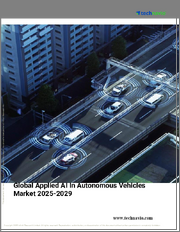
|
시장보고서
상품코드
1677921
자율주행차 개발 플랫폼 시장 규모, 점유율, 성장 분석 : 플랫폼 유형별, 차종별, 최종사용자별, 지역별 - 산업 예측(2025-2032년)Autonomous Vehicle Development Platform Market Size, Share, and Growth Analysis, By Platform Type (Software, Services), By Vehicle Type (Passenger Car, Light Commercial Vehicles), By End User, By Region - Industry Forecast 2025-2032 |
||||||
자율주행차 개발 플랫폼(AVDP) 시장 규모는 2023년에 346억 달러로, 2024년 423억 2,000만 달러에서 2032년에는 2,117억 9,000만 달러로 성장하며, 예측 기간(2025-2032년)의 CAGR은 22.3%로 추이할 전망입니다.
강화된 안전 기능과 친환경 솔루션에 대한 소비자 수요는 자동차 분야에서 자율주행 기술의 채택을 촉진하고 있습니다. 자율주행차 개발 플랫폼 세계 시장은 자율주행 기술과 전기자동차의 발전에 열광하는 정부와 민간 기업의 막대한 투자에 힘입어 크게 성장하고 있습니다. 복잡한 시나리오를 탐색할 수 있는 강력한 시스템의 필요성은 특히 운송 및 물류와 같은 주요 분야에서 가장 중요하며, AI, 머신러닝, 센서 기술의 급속한 발전은 LiDAR 및 컴퓨터 비전과 같은 혁신을 포함하여 자율주행차의 안전 및 탐색 능력을 향상시키고 있습니다. 향상시키고 있습니다. 또한 정부 지원책과 규제 프레임워크는 연구개발을 촉진하고 산업을 발전시키며 자율주행 솔루션에 대한 수요 증가에 부응하고 있습니다.
목차
서론
- 조사의 목적
- 조사 범위
- 정의
조사 방법
- 정보 조달
- 2차와 1차 데이터 방법
- 시장 규모 예측
- 시장의 전제조건과 제한
개요
- 세계 시장 전망
- 공급과 수요 동향 분석
- 부문별 기회 분석
시장 역학과 전망
- 시장 개요
- 시장 규모
- 시장 역학
- 촉진요인과 기회
- 억제요인과 과제
- Porter의 산업 분석
주요 시장 인사이트
- 주요 성공 요인
- 경쟁의 정도
- 주요 투자 기회
- 시장 에코시스템
- 시장의 매력 지수(2024년)
- PESTEL 분석
- 거시경제 지표
- 밸류체인 분석
- 가격 분석
- 규제 상황
- 사례 연구
- 기술의 진보
자율주행차 개발 플랫폼 시장 규모 : 플랫폼 유형별 & CAGR(2025-2032)
- 시장 개요
- 소프트웨어
- 서비스
자율주행차 개발 플랫폼 시장 규모 : 차종별 & CAGR(2025-2032)
- 시장 개요
- 승용차
- 소형 상용차
- 대형 상용차
자율주행차 개발 플랫폼 시장 규모 : 최종사용자별 & CAGR(2025-2032)
- 시장 개요
- 혼합 AVDP
- 이미지 기반 AVDP
- 센서 퓨전 기반 AVDP
자율주행차 개발 플랫폼 시장 규모 : 지역별 & CAGR(2025-2032)
- 북미
- 미국
- 캐나다
- 유럽
- 독일
- 스페인
- 프랑스
- 영국
- 이탈리아
- 기타 유럽 지역
- 아시아태평양
- 중국
- 인도
- 일본
- 한국
- 기타 아시아태평양
- 라틴아메리카
- 브라질
- 기타 라틴아메리카 지역
- 중동 및 아프리카
- GCC 국가
- 남아프리카공화국
- 기타 중동 및 아프리카
경쟁 정보
- 상위 5사의 비교
- 주요 기업의 시장 포지셔닝(2024년)
- 주요 시장 기업이 채택한 전략
- 최근 시장 동향
- 기업의 시장 점유율 분석(2024년)
- 주요 기업의 기업 개요
- 기업의 상세
- 제품 포트폴리오 분석
- 기업의 부문별 점유율 분석
- 매출의 전년대비 비교(2022-2024)
주요 기업 개요
- Volkswagen(Germany)
- Ford Motor Company(United States)
- Rivian Automotive(United States)
- Mitsubishi Motors Corporation(Japan)
- Great Wall Motor(China)
- SAIC Motor Corporation Limited(China)
- ZF Friedrichshafen AG(Germany)
- Toyota Motor Corporation(Japan)
- General Motors Company(United States)
- Tesla, Inc.(United States)
- Honda Motor Co., Ltd.(Japan)
- Hyundai Motor Company(South Korea)
- Nissan Motor Co., Ltd.(Japan)
- BMW AG(Germany)
- Daimler AG(Germany)
- Audi AG(Germany)
- Porsche AG(Germany)
- Subaru Corporation(Japan)
결론과 제안
KSA 25.04.18Autonomous Vehicle Development Platform Market size was valued at USD 34.6 billion in 2023 and is poised to grow from USD 42.32 billion in 2024 to USD 211.79 billion by 2032, growing at a CAGR of 22.3% during the forecast period (2025-2032).
Consumer demand for enhanced safety features and eco-friendly solutions is driving the adoption of autonomous technologies in the automotive sector. The global market for autonomous vehicle development platforms is experiencing significant growth, fueled by substantial investments from both governments and private companies eager to advance autonomous technologies and electric vehicles. The need for robust systems capable of navigating complex scenarios is paramount, particularly in key sectors like transportation and logistics. Rapid advancements in AI, machine learning, and sensor technologies, including innovations like Lidar and computer vision, are elevating the safety and navigation capabilities of autonomous vehicles. Furthermore, supportive government initiatives and regulatory frameworks are fostering research and development, propelling the industry forward and meeting the escalating demand for autonomous solutions.
Top-down and bottom-up approaches were used to estimate and validate the size of the Autonomous Vehicle Development Platform market and to estimate the size of various other dependent submarkets. The research methodology used to estimate the market size includes the following details: The key players in the market were identified through secondary research, and their market shares in the respective regions were determined through primary and secondary research. This entire procedure includes the study of the annual and financial reports of the top market players and extensive interviews for key insights from industry leaders such as CEOs, VPs, directors, and marketing executives. All percentage shares split, and breakdowns were determined using secondary sources and verified through Primary sources. All possible parameters that affect the markets covered in this research study have been accounted for, viewed in extensive detail, verified through primary research, and analyzed to get the final quantitative and qualitative data.
Autonomous Vehicle Development Platform Market Segments Analysis
Global Autonomous Vehicle Development Platform Market is segmented by Platform Type, Vehicle Type, End User and region. Based on Platform Type, the market is segmented into Software and Services. Based on Vehicle Type, the market is segmented into Passenger Car, Light Commercial Vehicles and Heavy Commercial Vehicles. Based on End User, the market is segmented into Mixed AVDP, Image-Based AVDP and Sensor Fusion-based AVDP. Based on region, the market is segmented into North America, Europe, Asia Pacific, Latin America and Middle East & Africa.
Driver of the Autonomous Vehicle Development Platform Market
The Autonomous Vehicle Development Platform market is significantly driven by the availability of robust software frameworks that facilitate the integration of essential components necessary for autonomous vehicles. These components encompass perception, decision-making, sensor fusion, mapping, localization, and control systems. A cohesive platform not only simplifies the development process but also enhances the interaction among these systems, ensuring efficient collaboration. By providing developers with pre-built modules, libraries, and APIs, these platforms accelerate the overall development timeline, enabling quicker innovation and deployment in the autonomous vehicle sector. Thus, the advancement and accessibility of these platforms play a crucial role in driving market growth.
Restraints in the Autonomous Vehicle Development Platform Market
The Autonomous Vehicle Development Platform market faces several restraints primarily due to the substantial research and development efforts required to create a comprehensive platform. This process involves the development of sophisticated algorithms, software frameworks, and simulation environments, as well as the integration of advanced technologies. Such tasks demand a significant investment in skilled workforce and technological infrastructure. Consequently, the high initial costs associated with these platforms could restrict access for smaller companies, startups, and research institutions. This financial barrier could inhibit their potential to compete effectively or make meaningful contributions to the advancement of autonomous vehicle technologies.
Market Trends of the Autonomous Vehicle Development Platform Market
The Autonomous Vehicle Development Platform market is witnessing a significant trend towards collaboration and partnerships among technology companies, automotive manufacturers, and research institutions. These strategic alliances are essential for leveraging combined resources and expertise to expedite innovation and development. Technology firms contribute their proficiency in artificial intelligence, machine learning, and advanced sensor technologies, while automotive manufacturers provide invaluable insights into vehicle design, manufacturing processes, safety protocols, and compliance with regulatory frameworks. This synergistic approach not only enhances the efficiency of developing autonomous vehicles but also fosters a more robust ecosystem, ultimately facilitating the rapid commercialization and adoption of autonomous technologies, shaping the future of mobility.
Table of Contents
Introduction
- Objectives of the Study
- Scope of the Report
- Definitions
Research Methodology
- Information Procurement
- Secondary & Primary Data Methods
- Market Size Estimation
- Market Assumptions & Limitations
Executive Summary
- Global Market Outlook
- Supply & Demand Trend Analysis
- Segmental Opportunity Analysis
Market Dynamics & Outlook
- Market Overview
- Market Size
- Market Dynamics
- Drivers & Opportunities
- Restraints & Challenges
- Porters Analysis
- Competitive rivalry
- Threat of substitute
- Bargaining power of buyers
- Threat of new entrants
- Bargaining power of suppliers
Key Market Insights
- Key Success Factors
- Degree of Competition
- Top Investment Pockets
- Market Ecosystem
- Market Attractiveness Index, 2024
- PESTEL Analysis
- Macro-Economic Indicators
- Value Chain Analysis
- Pricing Analysis
- Regulatory Landscape
- Case Studies
- Technological Advancement
Global Autonomous Vehicle Development Platform Market Size by Platform Type & CAGR (2025-2032)
- Market Overview
- Software
- Services
Global Autonomous Vehicle Development Platform Market Size by Vehicle Type & CAGR (2025-2032)
- Market Overview
- Passenger Car
- Light Commercial Vehicles
- Heavy Commercial Vehicles
Global Autonomous Vehicle Development Platform Market Size by End User & CAGR (2025-2032)
- Market Overview
- Mixed AVDP
- Image-Based AVDP
- Sensor Fusion-based AVDP
Global Autonomous Vehicle Development Platform Market Size & CAGR (2025-2032)
- North America (Platform Type, Vehicle Type, End User)
- US
- Canada
- Europe (Platform Type, Vehicle Type, End User)
- Germany
- Spain
- France
- UK
- Italy
- Rest of Europe
- Asia Pacific (Platform Type, Vehicle Type, End User)
- China
- India
- Japan
- South Korea
- Rest of Asia-Pacific
- Latin America (Platform Type, Vehicle Type, End User)
- Brazil
- Rest of Latin America
- Middle East & Africa (Platform Type, Vehicle Type, End User)
- GCC Countries
- South Africa
- Rest of Middle East & Africa
Competitive Intelligence
- Top 5 Player Comparison
- Market Positioning of Key Players, 2024
- Strategies Adopted by Key Market Players
- Recent Developments in the Market
- Company Market Share Analysis, 2024
- Company Profiles of All Key Players
- Company Details
- Product Portfolio Analysis
- Company's Segmental Share Analysis
- Revenue Y-O-Y Comparison (2022-2024)
Key Company Profiles
- Volkswagen (Germany)
- Company Overview
- Business Segment Overview
- Financial Updates
- Key Developments
- Ford Motor Company (United States)
- Company Overview
- Business Segment Overview
- Financial Updates
- Key Developments
- Rivian Automotive (United States)
- Company Overview
- Business Segment Overview
- Financial Updates
- Key Developments
- Mitsubishi Motors Corporation (Japan)
- Company Overview
- Business Segment Overview
- Financial Updates
- Key Developments
- Great Wall Motor (China)
- Company Overview
- Business Segment Overview
- Financial Updates
- Key Developments
- SAIC Motor Corporation Limited (China)
- Company Overview
- Business Segment Overview
- Financial Updates
- Key Developments
- ZF Friedrichshafen AG (Germany)
- Company Overview
- Business Segment Overview
- Financial Updates
- Key Developments
- Toyota Motor Corporation (Japan)
- Company Overview
- Business Segment Overview
- Financial Updates
- Key Developments
- General Motors Company (United States)
- Company Overview
- Business Segment Overview
- Financial Updates
- Key Developments
- Tesla, Inc. (United States)
- Company Overview
- Business Segment Overview
- Financial Updates
- Key Developments
- Honda Motor Co., Ltd. (Japan)
- Company Overview
- Business Segment Overview
- Financial Updates
- Key Developments
- Hyundai Motor Company (South Korea)
- Company Overview
- Business Segment Overview
- Financial Updates
- Key Developments
- Nissan Motor Co., Ltd. (Japan)
- Company Overview
- Business Segment Overview
- Financial Updates
- Key Developments
- BMW AG (Germany)
- Company Overview
- Business Segment Overview
- Financial Updates
- Key Developments
- Daimler AG (Germany)
- Company Overview
- Business Segment Overview
- Financial Updates
- Key Developments
- Audi AG (Germany)
- Company Overview
- Business Segment Overview
- Financial Updates
- Key Developments
- Porsche AG (Germany)
- Company Overview
- Business Segment Overview
- Financial Updates
- Key Developments
- Subaru Corporation (Japan)
- Company Overview
- Business Segment Overview
- Financial Updates
- Key Developments



















